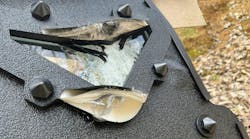Prevailing wisdom has it that crowds can be unpredictable even under the best of circumstances. Toss in a fire, a terrorist attack or some other kind of emotionally fraught incident (such as a hotly contested soccer match) and crowds can mutate into a panicked, unruly mob that defies any law enforcement effort to regain order and get them out of harm's way. This mass of humanity on-the-hoof can turn the most carefully constructed crowd control or evacuation plan into a ham-handed attempt that fails miserably, even dangerously.
The human element, factoring in how a mass of people will likely react under differing emergency scenarios, is an essential part of devising effective crowd management and evacuation strategies. Yet this element has gone missing from most emergency management preplanning software programs. However, Rontal Applications Ltd. has designed an innovative software platform that takes this into account. Dubbed SimGuard, the incident management system considers the varied and conditional human behavior in emergencies through a crowd-behavior prediction module. The company recently released an extension to the module that offers additional enhancements to SimGuard's Crowd-behavior Scenarios Database.
Rontal Applications is headquartered in Lod, Israel, although it has recently opened a U.S. location in Virginia. The company was founded approximately four years ago by experienced aviators, who drew their inspiration for SimGuard from changes that took place in the cockpit, says co-founder and CEO Roni Zehavi.
"If you look at the evolution of the cockpit, in 1915 there were just three to five gauges," Zehavi says. "It was very easy to monitor. But by the 1970s, the number of gauges had grown to 100 to 150. It became impossible to monitor all of them. At some point, people started asking why they had to monitor every single piece of information. Why not just look at the most important?
"Now, if you go into modern cockpits, you will see they have just three screens that monitor situation awareness," he continues. "We do the same thing with this system; we analyze the data and with one screen we allow the operator to fully monitor a situation, what is happening, what are the consequences, and what he needs to do."
Preplanning evacuationsSimGuard is designed to allow end-users, those tasked with managing large-scale evacuations, to more effectively pre-plan evacuation strategies and test their efficacy. The platform can also conduct realistic training on these scenarios as well. The new extension improves the system's ability to predict behavior through the enhanced manipulation of an animated virtual crowd, which enables operators to better examine how crowds, differing in composition, may react to various emergency situations.
The software enables end-users to identify escape routes and anticipate how the routes might be affected by different events, such as a bomb blast versus fire or smoke, etc. The system stores the plans and in the case of an actual event, calls them up and guides the operator's response. Because the system monitors events as they happen, via real-time sensors, end-users can also react immediately to changes — such as blocked exits, bottlenecks or other unexpected obstacles — that could hinder a timely evacuation.
Let's use an example of a correctional facility to explain how real-time sensing works.
SimGuard would take all the existing sensor deployments from the jail, such as cameras, inputting their positions exactly as they exist in the facility into the program. Also included would be location of other sensors such as gates, doors and fire detectors. Using blueprints and digital photos, the company would combine and load structural and sensory information into the software, building a three-dimensional (3D) model of the facility, creating a virtual site of the real thing that includes multi-layered display of pipes, electricity and phone cables, escape routes, etc., Zehavi explains.
Zehavi notes that if a facility doesn't have sufficient coverage, the gaps would show at this stage, which is an added value of SimGuard. Zehavi explains that although people are acquiring more cameras, they are often located in really random, less-than-optimal places. For example, positioning cameras based on where the power outlets are does not necessarily provide the best coverage.
"We take [into condsideration] the various threats jail security is most concerned about and for each one of these, we say, 'OK, if this scenario happens, let's see what this will look like and what we have to do,' and so on," says Zehavi. "Once we are happy with all the scenarios and contingency plans, we load them into the system, where they can be used for realistic training scenarios and also in real time if they occur."
SimGuard superimposes the scenarios over the facility's 3D geospatial representation, identifying and numbering each. In the case of an actual event, the system will pull up the appropriate plan and then direct the response. This is particularly valuable during high-stress events, when alarms are ringing and people are shouting, all of which rattles the nerves of the most seasoned operator or responder, says Zehavi. Through real-time sensors, operators are kept abreast of any changes, which will allow them to stay up to date if, for example, there is a number of people gathered in one area or access is altered. Operators can then respond accordingly.
Merging info and geographyThe system is unique because it merges real-world information and real-time geography into a 3D virtual realistic world, Zehavi, says. The extended module allows for the setting of up to 50 parameters, including different kinds of environmental conditions such as smoke, fire, bombing, gas leak or power failure, which could damage potential escape routes, enabling operators to identify alternate ones. Operators can run combinations of factors to obtain the most accurate prediction of crowd behavior at any time, identify and preplan the most effective evacuation strategy and route for a given situation, and anticipate what could go wrong.
For example, it can show a virtual crowd of people running around, confused and going to the wrong place. Operators can vary the level of panic and manipulate the demographics of the virtual mass, such as age, ethnicity and gender. Thus, in a jail, plans would likely vary depending upon whether it was a women's or a men's facility, and also by the average age.
Public safety useZehavi says the company's first sale was in 2005 to Barclay's headquarters in London, in the Canary Warf area, where most of the international banks are located. The company has done smaller installations in Israel and currently has a large project underway in Europe (they're putting this system into 42 sites belonging to one corporation). It is just now making inroads into the United States, doing a "very big job" at an undisclosed West Coast airport. Zehavi thinks the law enforcement and first responder markets hold lots of potential for SimGuard.
"All law enforcement officials have one thing in common," Zehavi says. "They face multiple-discipline incidents. And no matter what happens, whether the incident involves a city, several cities, one jail or 15, using this system, you can monitor everything from one site and gather and distribute this information in a common language to whoever needs it, whether police, fire, sheriff, whomever, and unify the response. There is no limit as to how many sites can be monitored from one location; the customer only has to decide how many incidents they want to handle."
The company is developing new modules on a continuous basis, says Zehavi. One currently in the works is designed to assist in preplanning responses to natural disasters.
Pamela Mills-Senn is a freelance writer based in Long Beach, California.


